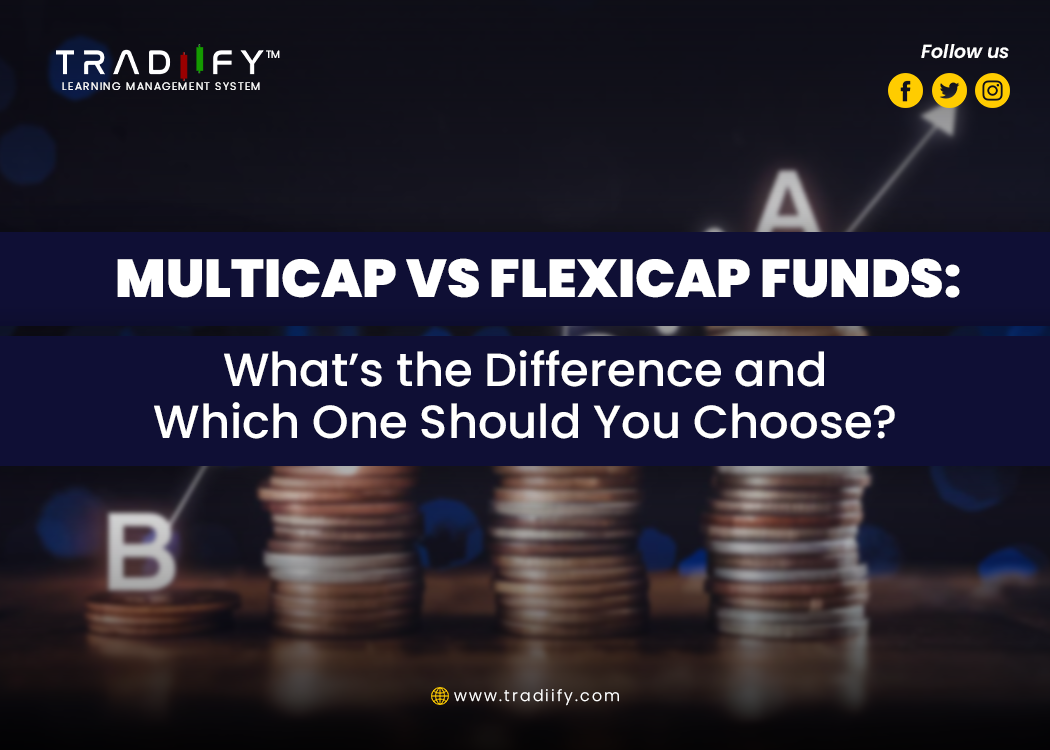
Investing in equity mutual funds can sometimes feel confusing, especially when you hear terms like Multicap Funds and Flexicap Funds. At first, they sound similar — both invest across large-cap, mid-cap, and small-cap stocks — but their rules and risk profiles are quite different.
Let’s break down the differences, advantages, and how to choose between them.
What Are Market Capitalizations?
Market capitalization is the total market value of a company’s outstanding shares. Based on this, companies are divided into
- Large Cap: Top 100 companies by market cap
- Mid Cap: Companies ranked 101–250
- Small Cap: Companies ranked 251 and beyond
What is a Multicap Fund?
A Multicap Fund is an open-ended equity fund that invests in large-cap, mid-cap, and small-cap stocks. As per SEBI’s rule, it must invest a minimum of 25% of its total assets in each category:
- 25% in Large Cap
- 25% in Mid Cap
- 25% in Small Cap
- The remaining 25% is free to be allocated as per the fund manager’s choice.
This ensures balanced exposure across different segments of the market.
What is a Flexicap Fund?
A Flexicap Fund is also an open-ended equity fund that invests in large-, mid-, and small-cap stocks, but with complete flexibility. There are no fixed percentage rules. The fund manager can invest in any proportion based on market opportunities and trends.
For example, if large-cap stocks are performing well, the fund manager might invest 70-80% in them. If small-cap stocks rally, they can increase exposure there. This makes Flexicap Funds highly dynamic.
Key Differences
1. SEBI Mandate
Multicap Funds: 25% minimum in large, mid, and small-cap each
Flexicap Funds: No such restriction—100% flexibility
2. Flexibility
Multicap Funds: Limited — must follow the 25-25-25 rule.
Flexicap Funds: High — can change allocations anytime
3. Risk Profile
Multicap Funds: Moderately high, balanced exposure
Flexicap Funds: Variable — depends on fund manager’s strategy
4. Market Timing Advantage
Multicap Funds: Less scope for tactical moves
Flexicap Funds: More scope for dynamic allocation
5. Suitable for
Multicap Funds: Investors seeking balanced, diversified growth
Flexicap Funds: Investors comfortable with active, tactical fund management
Pros and Cons
Multicap Funds:
+ Balanced risk-return profile
+ Mandatory diversification limits volatility.
+ Good for medium- to long-term investors
- Limited flexibility to capture market opportunities
- Fixed exposure to small-caps may increase risk
Flexicap Funds:
+ Highly dynamic and market-responsive
+ Potential for better returns in certain market phases
+ Allows active risk management
- Heavily dependent on fund manager’s skill
- Can get concentrated in one category, increasing risk
Which One Should You Choose?
Choose a Multicap Fund if:
- You prefer a balanced, all-weather portfolio.
- You don’t want to be overexposed to any single market cap.
- You’re a moderate risk-taker looking for long-term growth.
Choose a Flexicap Fund if:
- You’re comfortable with a fund manager actively managing your money.
- You believe in dynamic asset allocation based on market trends.
- You want potentially higher returns with variable risk.
Final Thoughts
Both Multicap and Flexicap funds offer exposure across market capitalizations. Multicaps enforce balanced allocation while Flexicaps allow fund managers to tactically shift allocations. Align your fund choice with your financial goals, risk tolerance, and investment horizon.
Comments (0)
Categories
Recent posts


Getting Started with Tradiify LMS: A ...
1 Aug 2024
5 Ways an LMS Can Revolutionize Your ...
1 Aug 2024.jpg)
How Tradiify LMS Supports Continuous ...
1 Aug 2024




